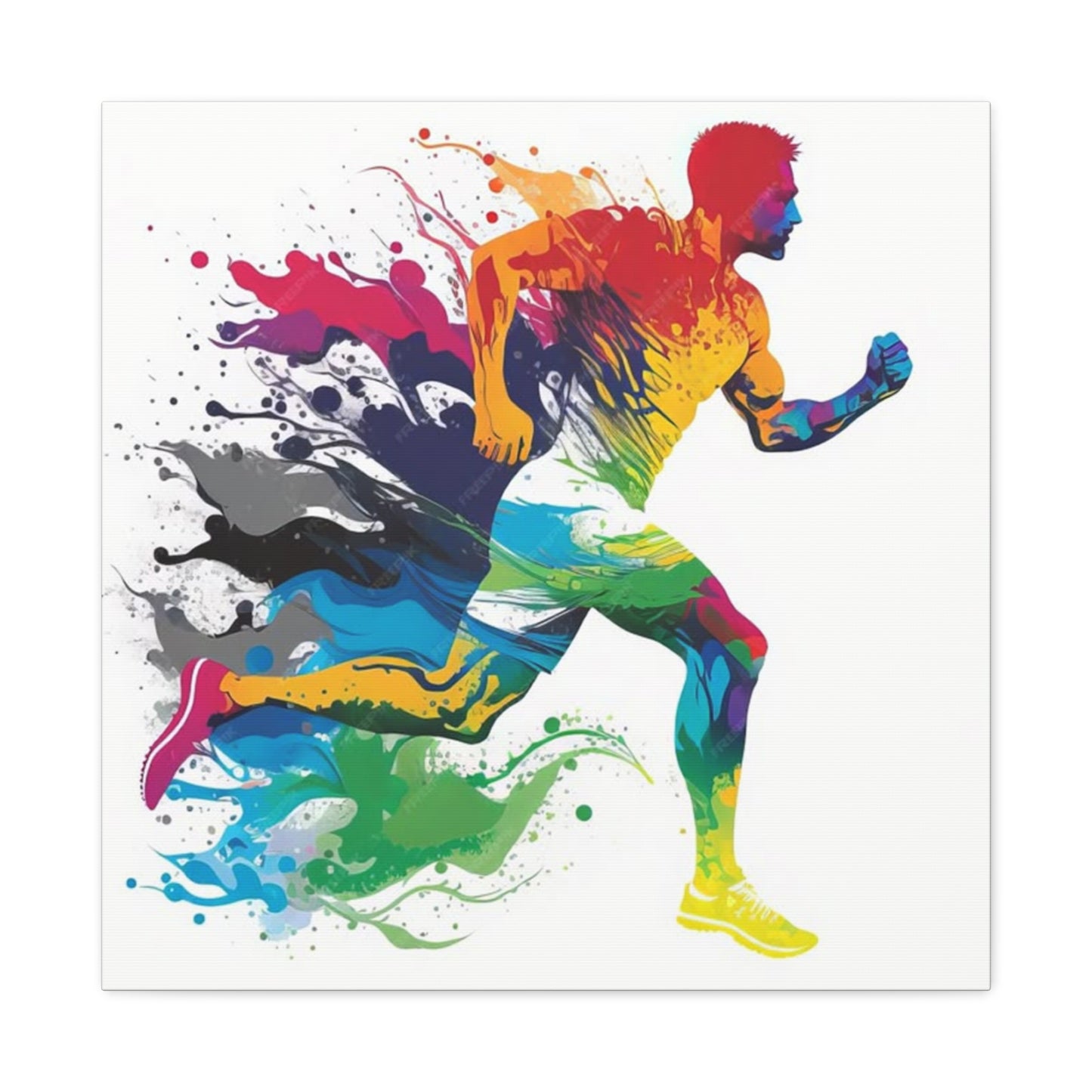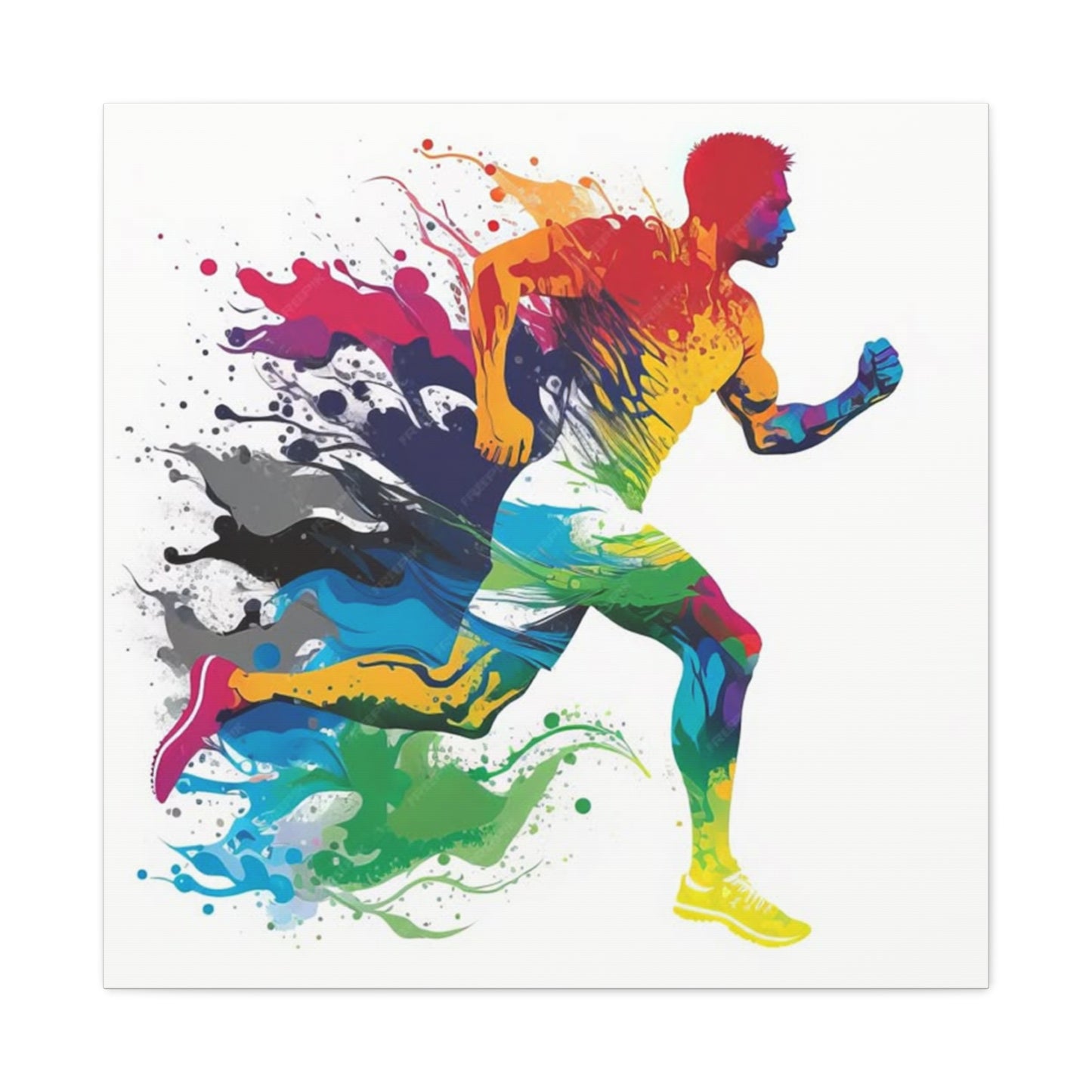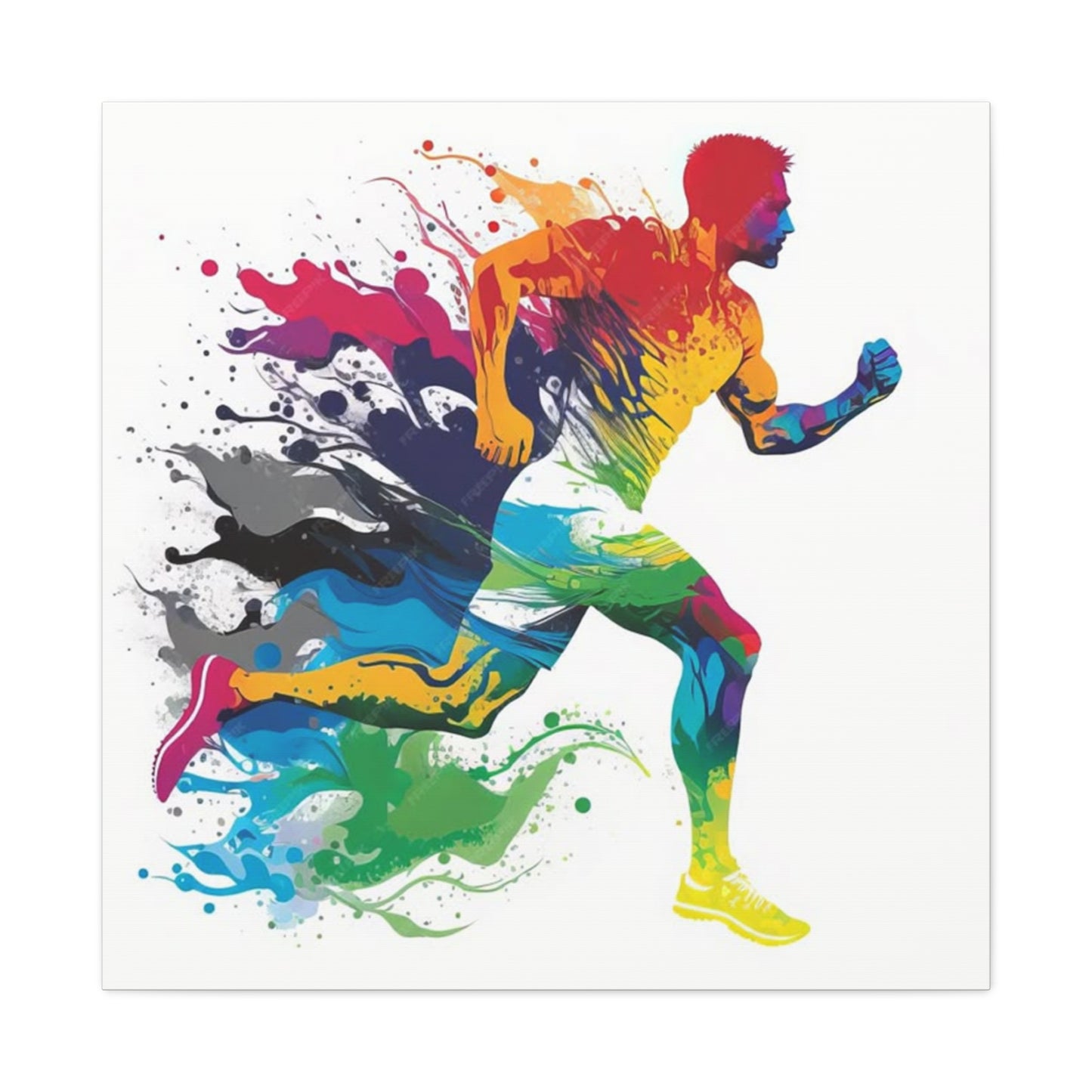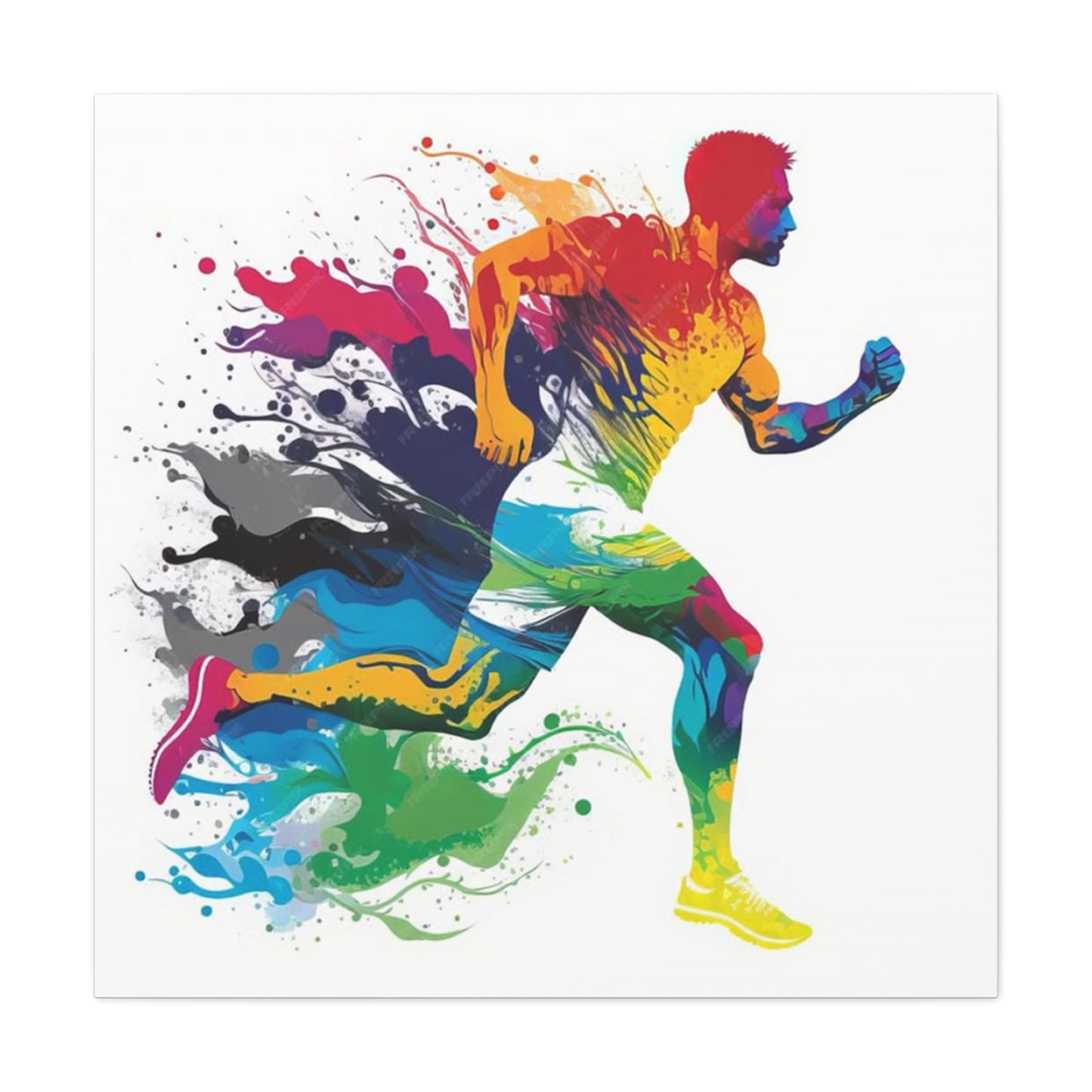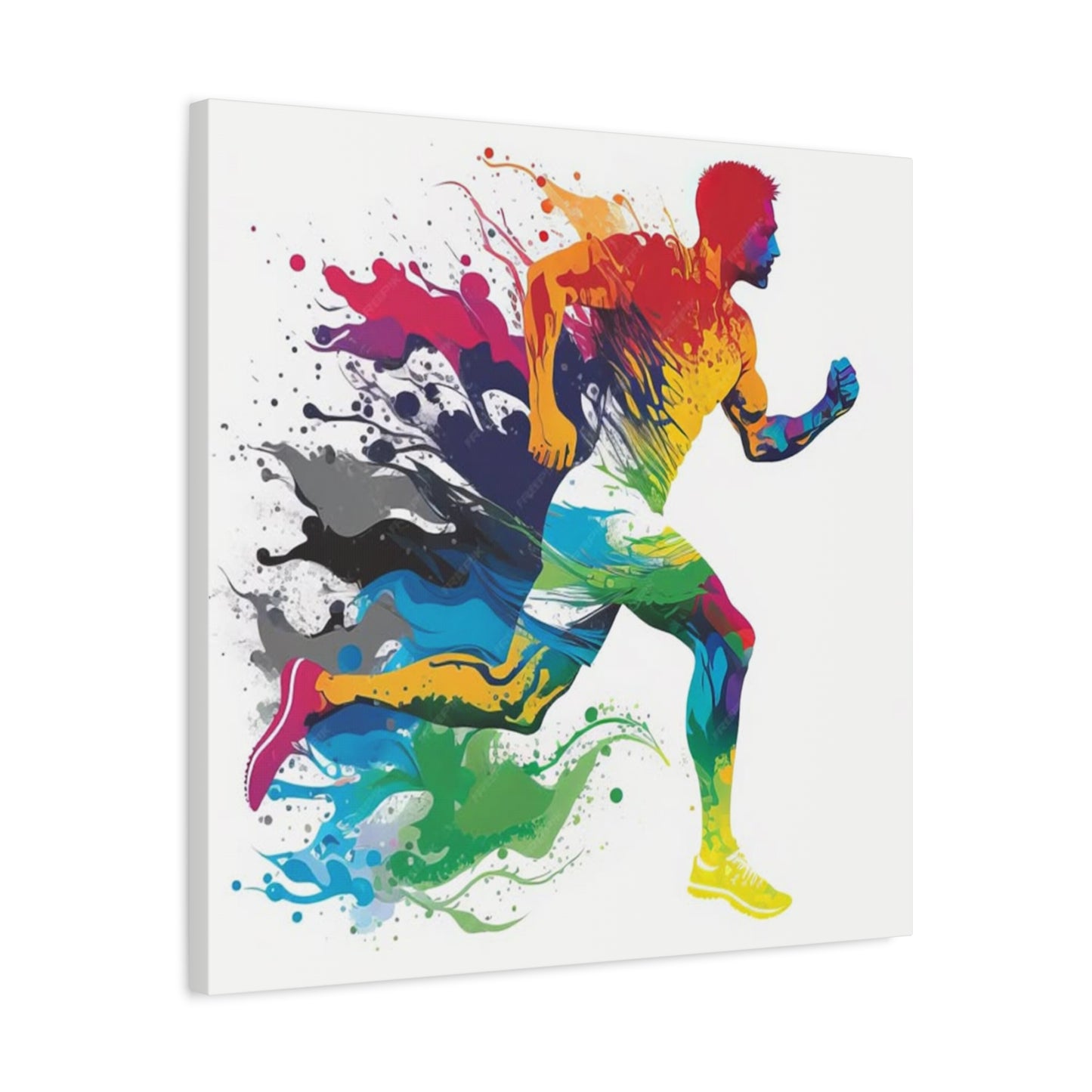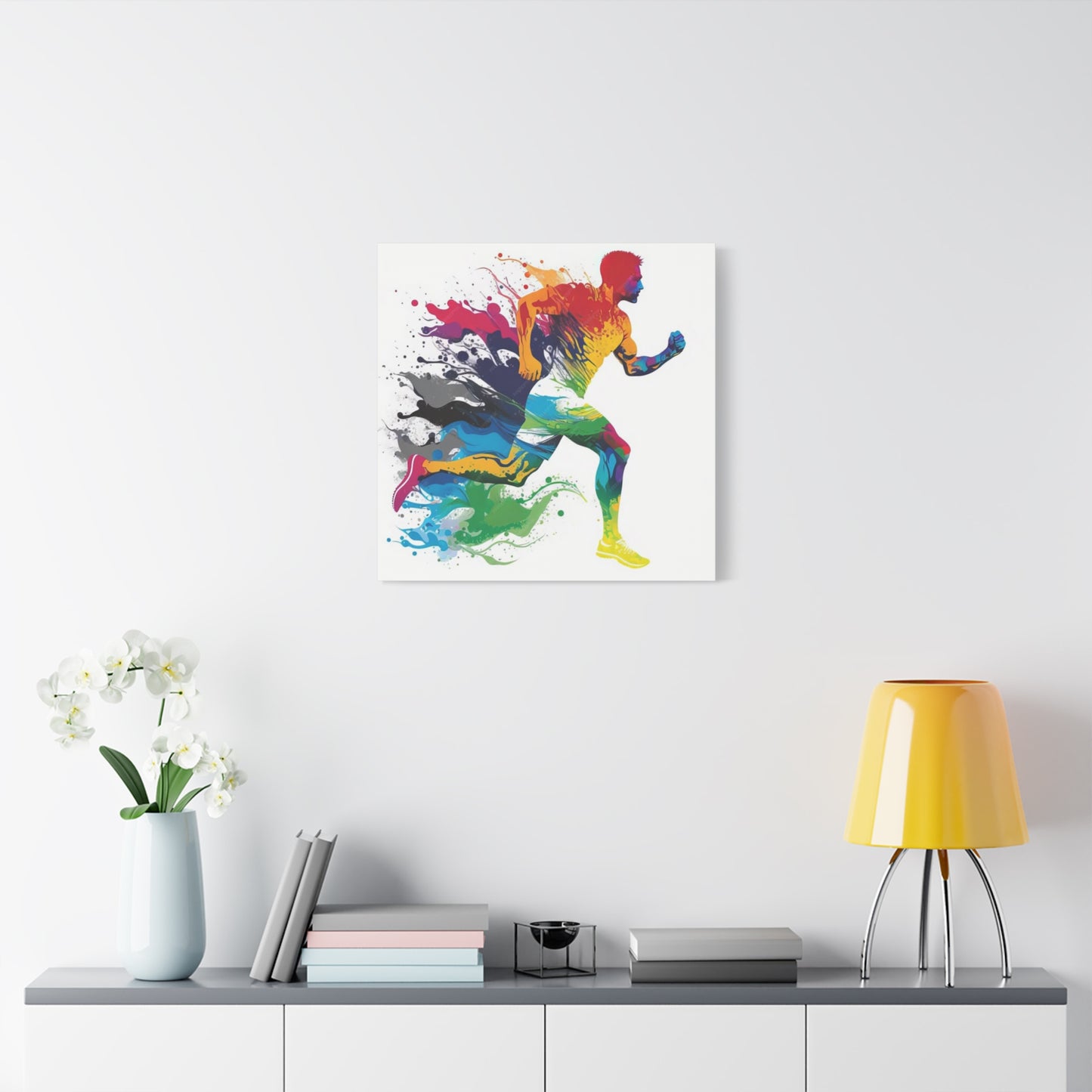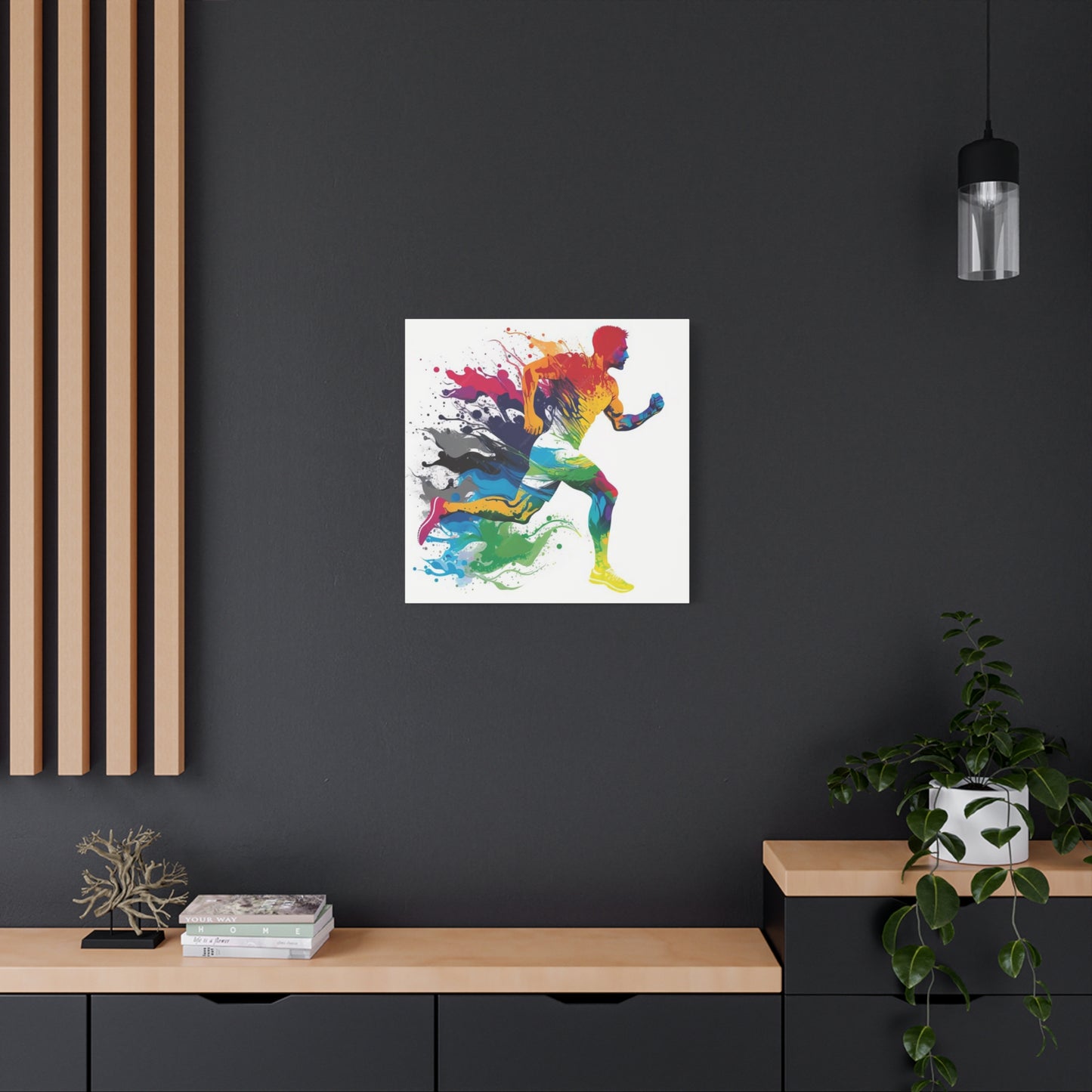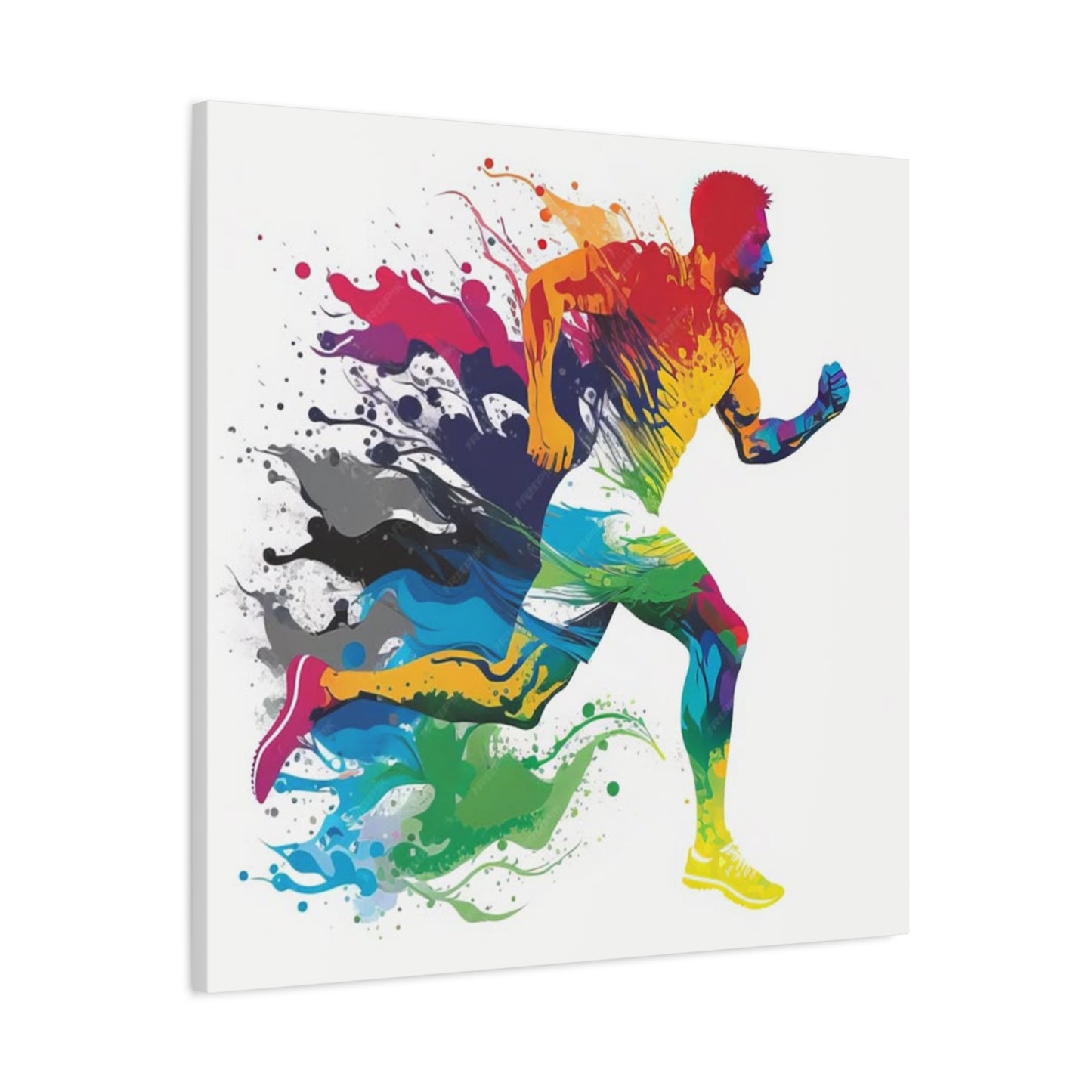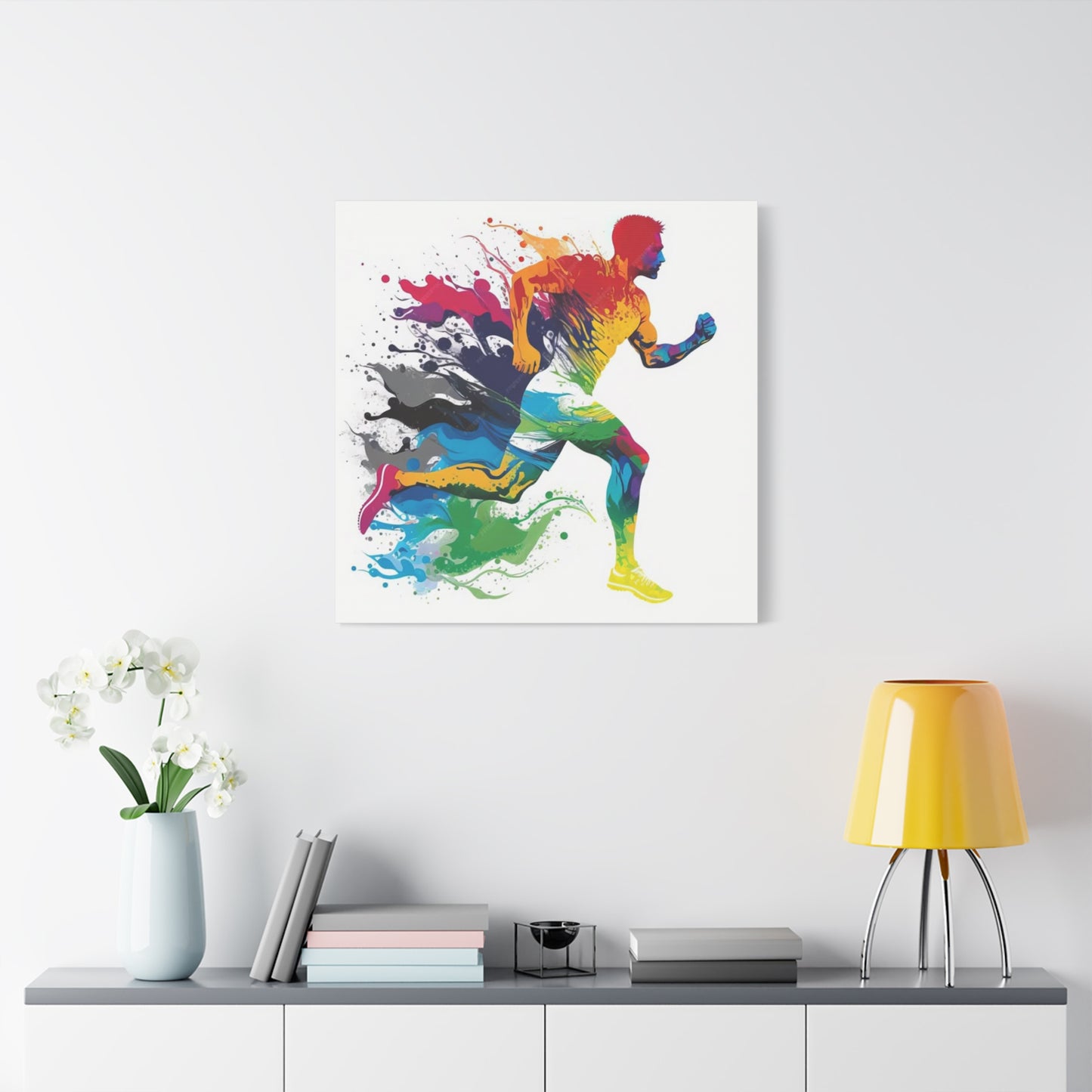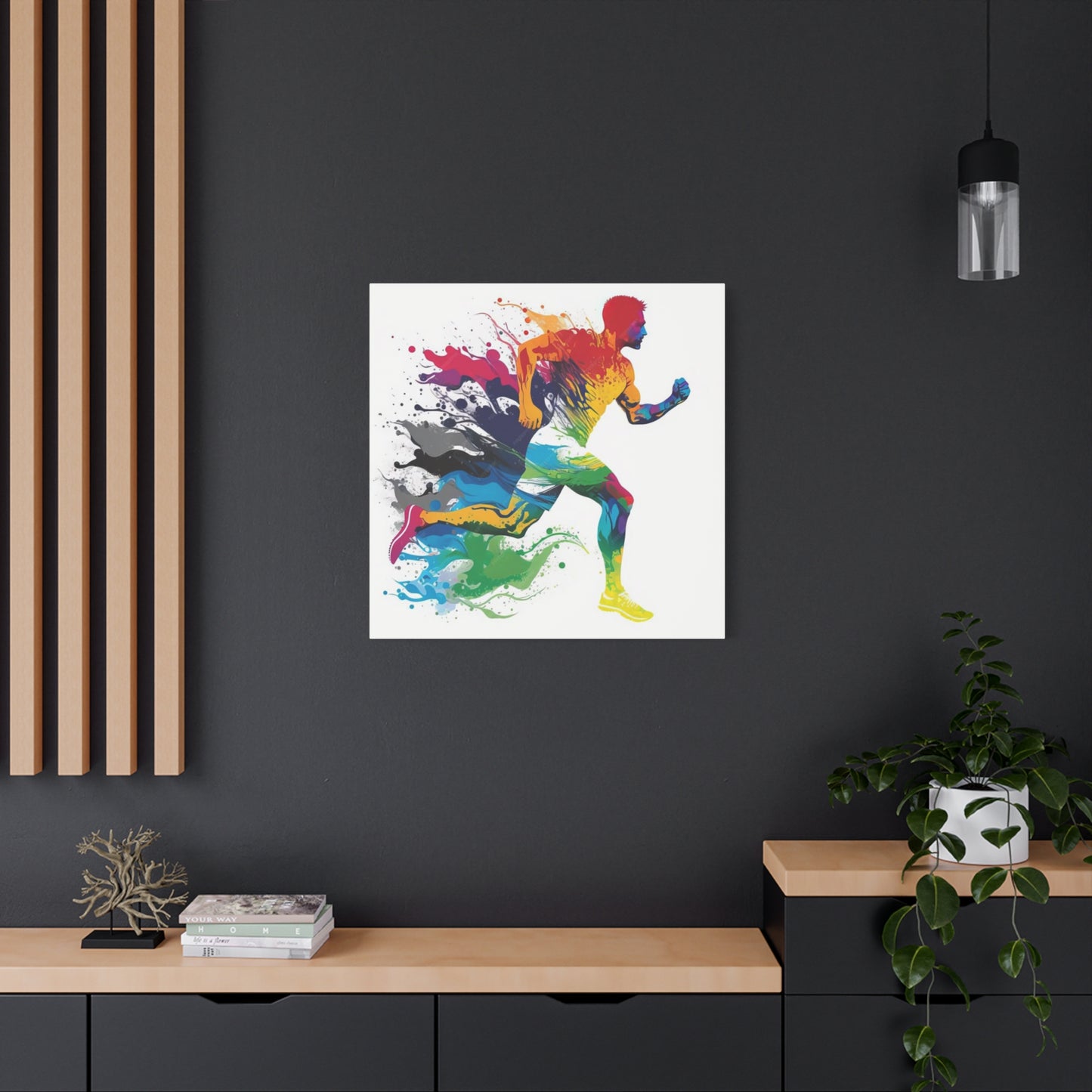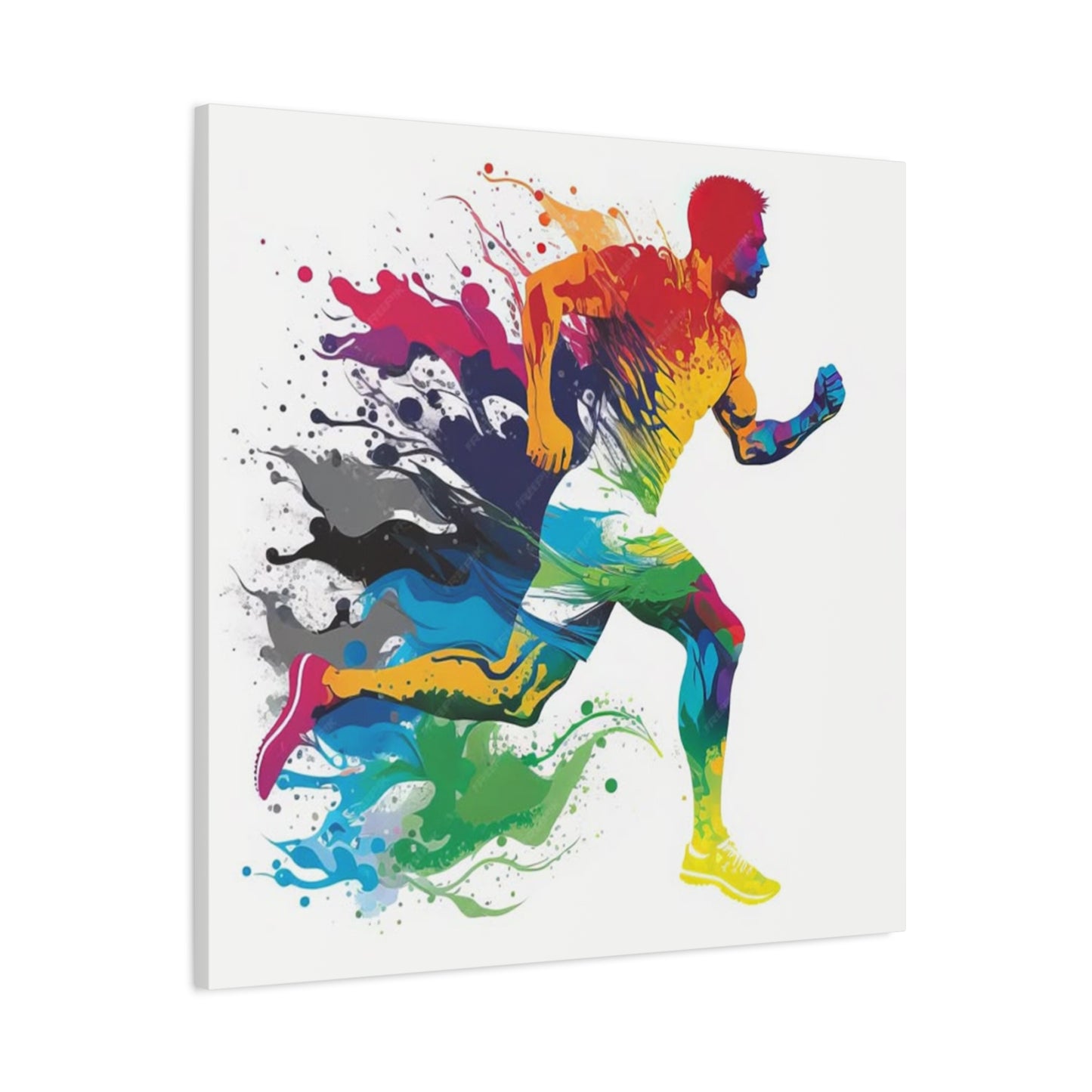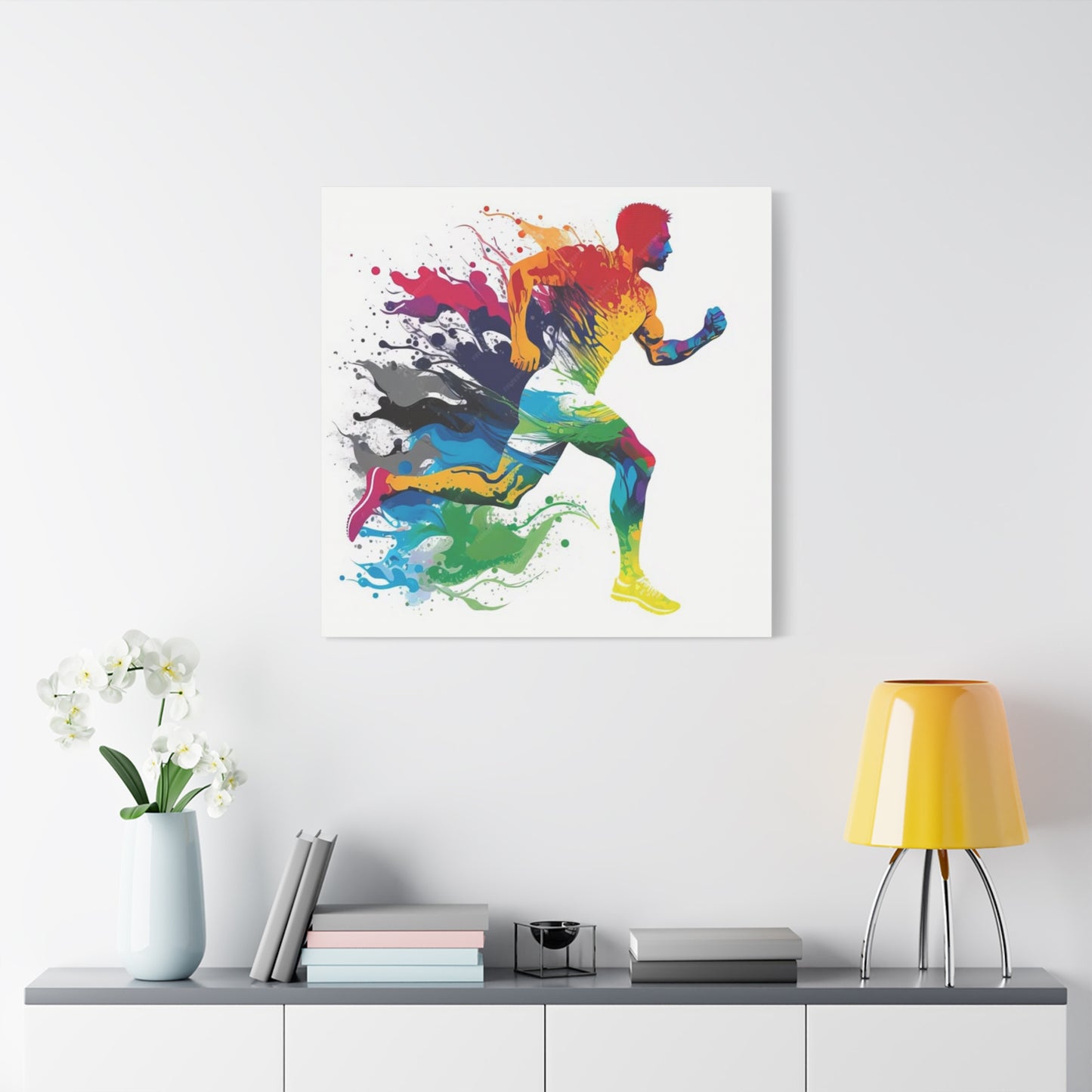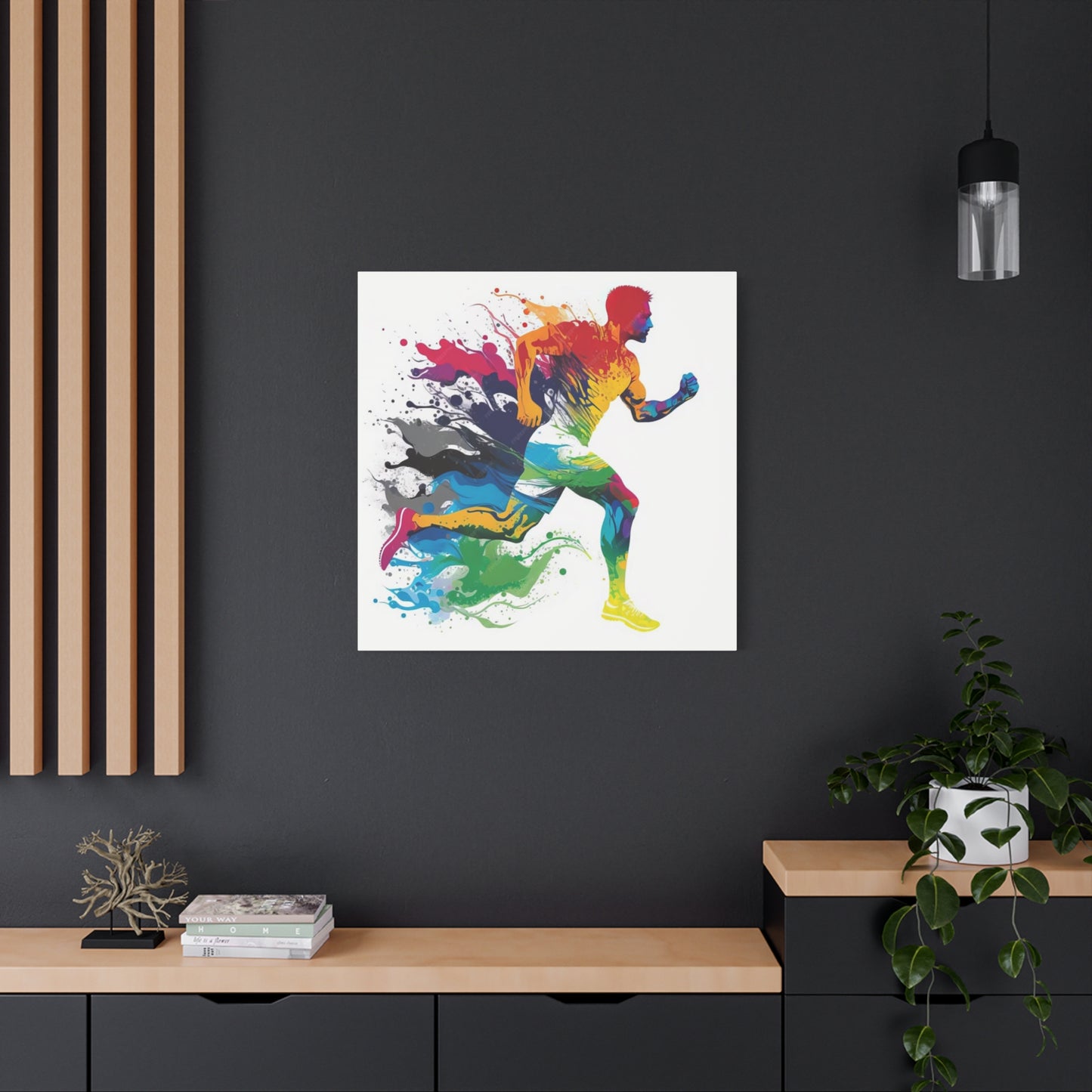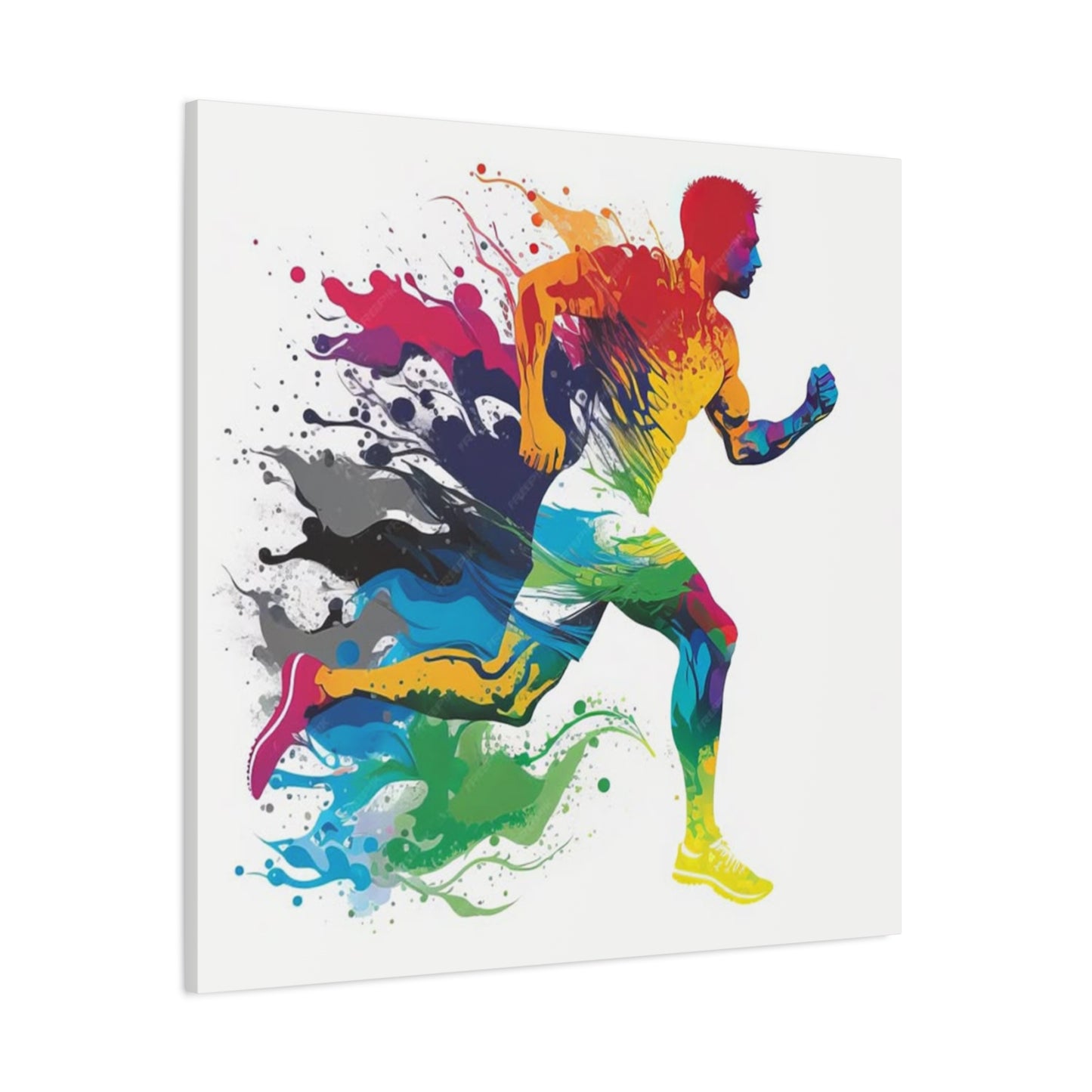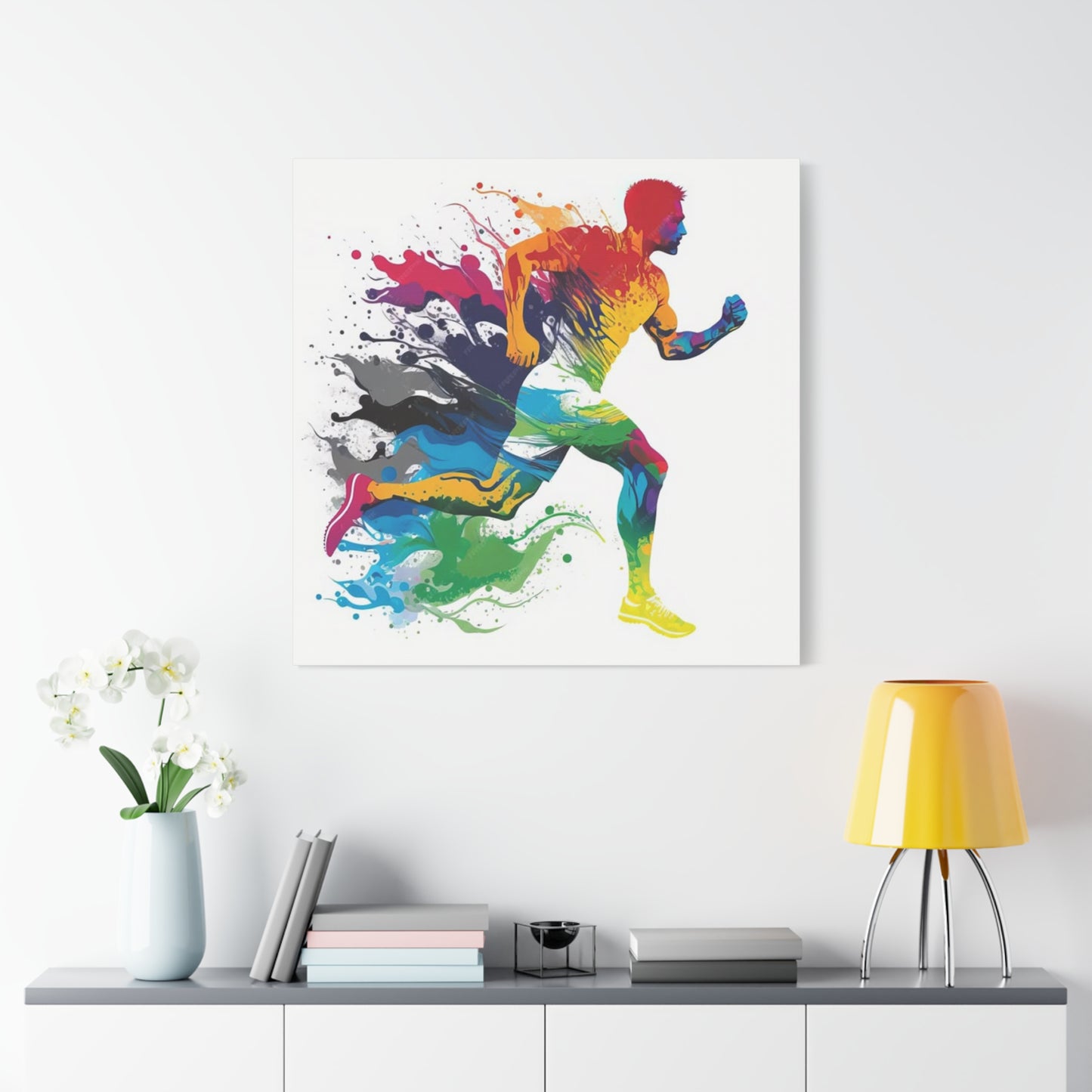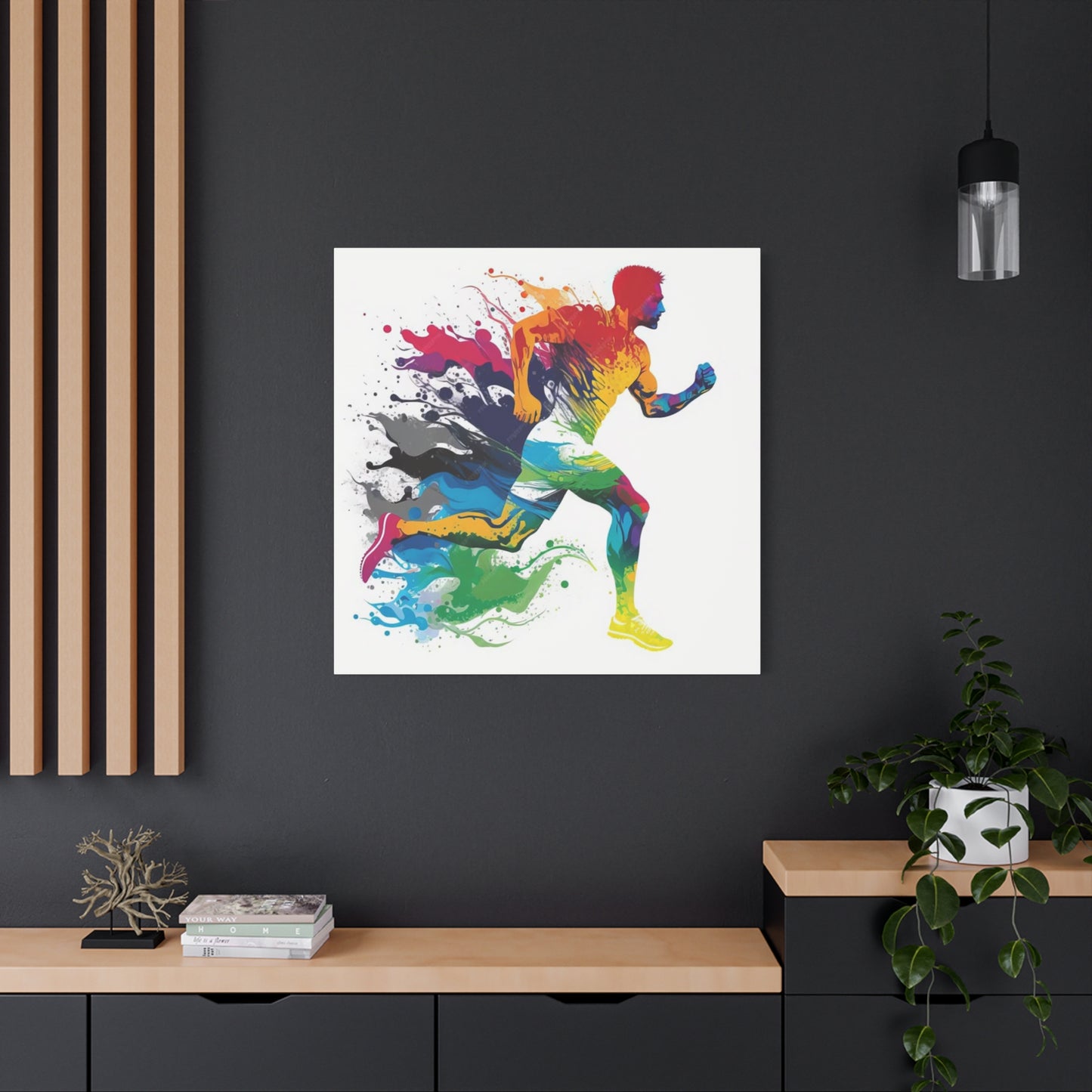Dynamic Movement: Running Graffiti Wall Art That Energizes Every Room
Running graffiti wall art represents a powerful fusion of urban expression and athletic dynamism that captures the essence of movement in its purest form. This artistic medium transforms static surfaces into vibrant canvases that pulsate with kinetic energy, creating visual narratives that speak to the human spirit's desire for freedom and forward momentum. The marriage between street art aesthetics and running themes produces artwork that transcends traditional boundaries, offering viewers an immersive experience that connects them to both urban culture and athletic aspiration.
The evolution of running graffiti has emerged from the streets where both art forms originated, reflecting the raw authenticity of urban environments while celebrating the universal language of human movement. Artists working in this genre understand that running represents more than physical activity; it embodies liberation, determination, and the relentless pursuit of personal goals. When translated into graffiti form, these concepts manifest through bold strokes, dynamic compositions, and color schemes that mirror the intensity of athletic endeavor.
Contemporary running graffiti incorporates various techniques that enhance the sense of motion within static artwork. Artists employ blur effects, trailing lines, and fragmented imagery to suggest speed and continuous movement. These visual elements create an optical illusion that makes viewers feel as though they are witnessing actual motion, transforming any room into a dynamic environment that energizes and motivates occupants.
The cultural significance of running graffiti extends beyond mere decoration, serving as a bridge between different communities and artistic traditions. Street artists who specialize in this genre often draw inspiration from both the athletic world and urban culture, creating pieces that resonate with diverse audiences. The artwork speaks to runners who identify with the depicted motion, art enthusiasts who appreciate the technical skill involved, and anyone seeking to inject vitality into their living or working environment.
Technical execution in running graffiti requires mastery of multiple artistic disciplines, including traditional graffiti techniques, figure drawing, and understanding of kinetic principles. Artists must capture not just the physical appearance of runners but also the emotional and psychological aspects of the running experience. This involves studying body mechanics, understanding how clothing and hair move during athletic activity, and translating these observations into compelling visual compositions.
The color psychology employed in running graffiti plays a crucial role in conveying energy and movement. Warm colors like reds, oranges, and yellows suggest heat and intensity, while cool blues and greens can represent the flow and rhythm of sustained movement. Artists skillfully blend these color families to create compositions that evoke specific emotional responses and complement various environmental settings.
Running graffiti wall art serves multiple functional purposes beyond aesthetic appeal. In fitness facilities, these artworks provide motivation and visual stimulation that can enhance workout experiences. In residential settings, they create focal points that energize living areas and reflect the occupants' active lifestyle preferences. Corporate environments benefit from the dynamic energy these pieces bring, potentially inspiring employees to embrace more active approaches to their work and personal lives.
The production process for running graffiti involves careful planning and execution to ensure that the final piece effectively communicates motion and energy. Artists begin with preliminary sketches that explore different compositional approaches, experimenting with figure placement, background elements, and color schemes. Digital tools increasingly complement traditional methods, allowing artists to refine their concepts before committing to final execution.
Urban Vibes with Running-Themed Street Art
Running-themed street art brings authentic urban energy into any environment, transforming ordinary rooms into vibrant celebrations of city culture and athletic achievement. This artistic approach captures the pulse of metropolitan life while honoring the running community that navigates urban landscapes daily. The aesthetic draws heavily from the raw, unfiltered energy of city streets, incorporating elements like weathered textures, industrial color palettes, and typographic styles that reflect the urban experience.
The authenticity of urban-inspired running art stems from its roots in actual street culture, where artists have long used public surfaces to express personal and collective experiences. When adapted for residential and commercial applications, this artwork maintains its genuine character while providing the stability and refinement suitable for indoor environments. Artists working in this style understand the importance of preserving the spontaneous, rebellious spirit that defines street art while creating pieces appropriate for diverse settings.
Typographic elements play a significant role in running-themed street art, with artists incorporating text that ranges from motivational phrases to abstract letter forms that suggest movement and speed. These textual components often employ fonts and styling reminiscent of urban signage, creating visual connections to the city environment where running culture thrives. The integration of text and imagery creates layered compositions that reward close examination while maintaining strong visual impact from a distance.
Color schemes in urban running art typically reflect the industrial palette of city environments, featuring combinations of concrete grays, steel blues, rust oranges, and vibrant accent colors that pop against neutral backgrounds. This approach creates artwork that feels authentic to urban settings while providing sufficient visual interest to energize indoor environments. The careful balance between muted base tones and bright highlights mirrors the way colorful athletic wear stands out against urban backdrops.
Texture plays a crucial role in conveying urban authenticity, with artists employing techniques that simulate weathered surfaces, spray paint effects, and the layered appearance of street art that has evolved over time. These textural elements add depth and visual interest while creating tactile appeal that enhances the overall sensory experience of the artwork. Digital techniques can replicate these effects while ensuring consistency and durability in finished pieces.
The compositional approach in urban running art often incorporates asymmetrical layouts that suggest the organic, unplanned nature of street art creation. This aesthetic choice creates dynamic visual tension that keeps viewers engaged while reflecting the spontaneous energy of both running and urban artistic expression. Artists balance this seemingly chaotic approach with careful attention to visual hierarchy and focal point management.
Environmental integration becomes particularly important when bringing urban running art into refined settings. Successful pieces maintain their street credibility while complementing existing architectural and design elements. This requires careful consideration of scale, color relationships, and thematic connections that allow the artwork to enhance rather than overwhelm its surroundings.
The psychological impact of urban running art extends beyond visual appeal, creating atmospheric conditions that can influence mood and energy levels. The dynamic, rebellious character of street art can inspire viewers to embrace more adventurous approaches to their own lives and goals. For runners specifically, these artworks serve as constant reminders of the urban landscape they navigate and the community they belong to.
Contemporary urban running art increasingly incorporates mixed media approaches that combine traditional graffiti techniques with photography, digital elements, and three-dimensional components. This evolution reflects the changing nature of street art itself, as artists embrace new technologies and materials while maintaining connection to foundational principles and aesthetics.
Symbolism of Speed in Graffiti Art
The representation of speed within graffiti art transcends mere visual technique, evolving into a complex symbolic language that communicates themes of progress, escape, transformation, and human potential. Artists working with speed-related imagery understand that motion represents fundamental aspects of human experience, from the basic need for forward progress to the psychological desire for liberation from constraints. This symbolic depth transforms simple running figures into powerful metaphors that resonate on multiple levels with diverse audiences.
Speed symbolism in graffiti often manifests through visual metaphors that extend beyond literal representation of rapid movement. Artists employ techniques like motion blur, fragmented imagery, and dynamic line work to suggest not just physical velocity but also mental agility, emotional intensity, and spiritual transcendence. These artistic choices create layered meanings that reward contemplation while maintaining immediate visual impact.
The cultural context of speed symbolism varies significantly across different communities and artistic traditions. In urban environments, speed often represents the desire to escape limiting circumstances or to achieve upward mobility through determination and effort. For athletic communities, speed symbolizes the pursuit of excellence and the transcendence of physical limitations through training and dedication. These varying interpretations allow speed-themed graffiti to speak meaningfully to diverse audiences while maintaining universal appeal.
Temporal aspects of speed symbolism add additional complexity to graffiti compositions, with artists exploring themes related to fleeting moments, the passage of time, and the relationship between past, present, and future. Running figures can represent the forward momentum of personal growth, the urgency of seizing opportunities, or the cyclical nature of training and improvement. These temporal themes create intellectual depth that enhances the emotional impact of the artwork.
Color symbolism plays a crucial role in communicating speed-related concepts, with different hues conveying various aspects of rapid movement and its associated meanings. Red suggests urgency and intensity, while blue might represent flow and sustained effort. Yellow communicates energy and optimism, while green can symbolize growth and natural rhythm. Artists skillfully combine these color associations to create compositions that convey specific messages about speed and its significance.
The geometric aspects of speed representation involve careful consideration of line direction, angle relationships, and compositional flow. Diagonal lines suggest movement more effectively than horizontal or vertical elements, while curved lines can communicate fluid motion and natural rhythm. Artists manipulate these geometric relationships to create visual pathways that guide viewer attention while reinforcing thematic content related to movement and progress.
Psychological symbolism in speed-themed graffiti addresses deeper human experiences related to motivation, fear, desire, and aspiration. The act of running can represent the flight response to danger, the pursuit of goals, or the joy of physical freedom. Artists explore these psychological dimensions through facial expressions, body language, and environmental context that provides clues about the emotional state and motivations of depicted figures.
Historical connections between speed symbolism and cultural movements add richness to contemporary graffiti art, with artists drawing inspiration from various sources including ancient mythology, modern sports culture, and urban legends. These historical references create intellectual bridges that connect contemporary artwork to broader cultural narratives while maintaining relevance to current audiences and concerns.
The technical execution of speed symbolism requires mastery of advanced artistic techniques including perspective manipulation, atmospheric effects, and kinetic suggestion. Artists must understand how to create convincing illusions of motion within static media, employing tools and techniques that enhance the symbolic content while maintaining visual coherence and aesthetic appeal.
Bold Color Choices in Running Graffiti Prints
Color selection in running graffiti represents one of the most critical creative decisions artists make, as hue relationships directly influence emotional response, visual impact, and thematic communication. Bold color choices serve multiple functions beyond mere aesthetic appeal, creating psychological associations that enhance the artwork's ability to motivate, energize, and inspire viewers. The strategic use of vibrant colors can transform ordinary environments into dynamic spaces that reflect the intensity and passion associated with running culture.
The psychology of color in athletic-themed artwork draws from both scientific research and intuitive understanding of how different hues affect human perception and behavior. Warm colors like red, orange, and yellow create associations with energy, heat, and intensity that mirror the physical sensations experienced during vigorous exercise. These colors can physiologically increase heart rate and create feelings of excitement and motivation, making them particularly effective in fitness-related environments.
Cool colors including blue, green, and purple offer different psychological benefits, creating associations with flow, endurance, and mental clarity that complement the meditative aspects of distance running. These hues can promote feelings of calm focus and sustained effort, making them valuable for creating balanced compositions that address both the intensity and the zen-like qualities of running experience.
Contrast relationships between bold colors create visual tension and energy that mirrors the dynamic nature of athletic performance. Artists strategically employ complementary color pairs to create maximum visual impact while maintaining harmonic relationships that prevent overwhelming viewers. The careful balance between boldness and harmony ensures that artwork energizes without creating visual chaos or distraction.
Saturation levels play a crucial role in determining the emotional impact of color choices, with highly saturated hues creating intense, energetic effects while more muted tones suggest sophistication and subtlety. Running graffiti artists often employ varying saturation levels within single compositions to create visual hierarchy and guide viewer attention toward key elements while maintaining overall compositional unity.
Cultural associations with specific colors add layers of meaning to running graffiti, with artists considering how color choices might be interpreted by different demographic groups and cultural communities. Red might suggest power and determination in some contexts while representing danger or aggression in others. Understanding these cultural nuances allows artists to create more targeted and effective artwork that resonates appropriately with intended audiences.
The technical aspects of achieving bold colors in print reproduction require careful attention to color management, print technology, and material selection. Digital printing processes can reproduce vibrant colors that rival traditional paint media, but success depends on proper file preparation, color profile management, and selection of appropriate substrates that enhance color vibrancy while ensuring longevity.
Environmental considerations influence color selection as artists must account for lighting conditions, surrounding color schemes, and architectural elements that will interact with their artwork. Bold colors that appear striking in studio conditions may require adjustment to maintain their impact in specific installation environments. This requires careful planning and sometimes on-site color testing to ensure optimal results.
The emotional journey created through color progression within running graffiti compositions can mirror the physical and psychological experience of athletic performance. Artists might begin with cooler, calmer hues that suggest preparation and focus, building toward warmer, more intense colors that represent peak effort, before resolving to colors that suggest accomplishment and satisfaction. This color narrative creates viewing experiences that parallel running experiences.
Trends in bold color usage evolve constantly as artists experiment with new combinations and respond to changing cultural preferences and technological capabilities. Contemporary running graffiti increasingly incorporates neon and fluorescent elements that create dramatic effects under various lighting conditions, while also exploring subtle gradient techniques that add sophistication to bold color foundations.
Graffiti Meets Movement: Art That Runs
The intersection of graffiti aesthetics and kinetic representation creates a unique artistic category that challenges traditional boundaries between static visual art and dynamic performance. This fusion recognizes that both graffiti and running share fundamental characteristics: they are both forms of urban expression, both involve movement through public spaces, and both represent forms of rebellion against conventional expectations and limitations.
Historical connections between graffiti culture and urban running communities provide the foundation for contemporary artistic explorations that celebrate both traditions. Early graffiti artists often traversed cities on foot, developing intimate knowledge of urban landscapes that they shared with runners who navigated similar routes. This shared geographical experience creates natural thematic connections that contemporary artists explore through visual compositions that honor both cultural traditions.
The technical challenges of representing movement within graffiti require innovative approaches to composition, color application, and surface treatment. Artists must master techniques that suggest motion while working within the constraints of static media, employing methods such as multiple exposure effects, directional brush strokes, and strategic color placement to create convincing illusions of kinetic energy.
Philosophical themes emerge from the combination of graffiti and movement imagery, addressing concepts like freedom, transgression, urban exploration, and the relationship between individual expression and public space. Running represents personal journey and achievement, while graffiti represents public declaration and community communication. The combination creates artwork that speaks to both individual and collective human experiences.
The urban landscape serves as both inspiration and context for movement-based graffiti, with artists incorporating architectural elements, street textures, and environmental details that enhance the sense of place and authenticity. These environmental references create connections between artwork and specific locations while maintaining universal appeal that transcends geographical boundaries.
Contemporary digital techniques expand the possibilities for creating graffiti that suggests movement, allowing artists to experiment with effects that would be difficult or impossible to achieve through traditional methods alone. Digital tools enable precise control over motion blur, particle effects, and layered imagery that enhances the kinetic qualities of static compositions.
The scaling considerations for movement-based graffiti require careful attention to viewing distance and environmental context. Large-scale installations can accommodate more detailed movement suggestions and complex compositional elements, while smaller pieces must focus on essential elements that communicate motion efficiently within limited spatial constraints.
Community engagement plays an important role in the development of movement-based graffiti, with artists often collaborating with runners, coaches, and athletic organizations to ensure authentic representation of running culture and experiences. This collaboration results in artwork that resonates genuinely with the communities it represents while maintaining artistic integrity and creative innovation.
The therapeutic potential of movement-based graffiti extends beyond aesthetic appreciation, providing visual stimulation that can enhance motivation for physical activity and personal goal achievement. Healthcare facilities, rehabilitation centers, and therapeutic environments increasingly recognize the value of artwork that promotes active lifestyle choices and positive mental associations with physical movement.
Street Style Decor with Running Graffiti
Incorporating running graffiti into contemporary decor schemes requires a sophisticated understanding of how street art aesthetics can enhance rather than overwhelm residential and commercial environments. The key lies in balancing the raw, authentic energy of urban art with the refinement and functionality expected in modern living and working situations. This approach recognizes that street style has evolved from countercultural expression to mainstream design influence, offering opportunities to create unique, personalized environments.
The selection process for running graffiti decor involves careful consideration of scale, color relationships, and thematic coherence with existing design elements. Successful integration requires analyzing the architectural features, lighting conditions, and functional requirements of the intended installation area. Artists and decorators must work together to ensure that street-inspired artwork enhances the overall aesthetic vision while maintaining its authentic character and energetic impact.
Color coordination between running graffiti and existing decor presents both opportunities and challenges, as street art typically employs bold, saturated hues that may require careful balancing with more subdued interior elements. Successful approaches often involve using the artwork as a focal point while selecting complementary colors for surrounding elements, or alternatively, choosing graffiti pieces that incorporate neutral base tones with selective bright accents.
Textural considerations play a crucial role in integrating street style elements with contemporary decor, as the rough, weathered surfaces typical of authentic graffiti may contrast sharply with smooth, refined materials common in modern environments. Artists can address this through surface treatments that suggest urban authenticity while maintaining the durability and cleanliness standards required for indoor applications.
Lighting design becomes particularly important when showcasing running graffiti, as proper illumination can enhance the dynamic qualities of the artwork while ensuring it integrates harmoniously with the overall lighting scheme. Track lighting, accent spots, and even colored lighting can be employed to create dramatic effects that emphasize the kinetic aspects of the imagery while providing adequate illumination for functional needs.
The psychological impact of street style running graffiti in living and working environments can significantly influence mood, energy levels, and behavioral patterns. Research suggests that dynamic, energetic artwork can promote more active lifestyles and positive attitudes toward physical fitness, making running graffiti particularly valuable in homes where residents want to maintain active lifestyle commitments.
Maintenance considerations for street style decor require planning for long-term preservation of artwork while maintaining its authentic appearance. This involves selecting appropriate materials and protective treatments that prevent fading, moisture damage, and other environmental hazards without significantly altering the original aesthetic character of the pieces.
The scalability of street style running graffiti allows for flexible application across various environmental contexts, from large statement walls in loft apartments to smaller accent pieces in traditional homes. Artists can adapt their compositions to work effectively at different scales while maintaining visual impact and thematic coherence.
Contemporary trends in street style decor increasingly emphasize the integration of multiple media and dimensional elements that add physical depth and interactive potential to wall-based artwork. This evolution reflects the changing nature of street art itself, as artists experiment with new materials and techniques that expand expressive possibilities while maintaining connection to foundational principles.
How to Style Running Graffiti in Modern Environments
Successfully integrating running graffiti into modern environments requires a strategic approach that honors both the artistic integrity of street art and the functional requirements of contemporary living and working situations. The styling process begins with careful analysis of the existing architectural elements, color schemes, and usage patterns that characterize the intended installation environment. This foundational understanding enables decorators and residents to make informed decisions about artwork selection, placement, and complementary design elements.
The selection criteria for running graffiti in modern settings should balance artistic merit with practical considerations including size, color compatibility, and thematic appropriateness. Artwork that functions effectively in contemporary environments typically demonstrates sophisticated composition skills, refined color relationships, and subject matter that resonates with the occupants' lifestyle preferences and values. The goal is to find pieces that energize and inspire while maintaining harmony with existing design elements.
Placement strategies for running graffiti involve identifying locations where the artwork can achieve maximum visual impact without overwhelming the environment or interfering with functional activities. Focal walls, entryways, and areas with good natural or artificial lighting provide ideal locations for showcasing dynamic artwork. The viewing angles and traffic patterns within the environment should inform placement decisions to ensure the artwork is appreciated from multiple perspectives.
Color coordination techniques enable running graffiti to enhance rather than clash with existing interior color schemes. This might involve selecting artwork that incorporates accent colors already present in the environment, or alternatively, using the graffiti as inspiration for a broader color refresh that creates cohesive visual relationships throughout the area. The key is achieving balance between the bold character of street art and the sophistication expected in modern environments.
Lighting considerations play a crucial role in styling running graffiti effectively, as proper illumination can enhance the dynamic qualities of the artwork while ensuring it integrates seamlessly with the overall lighting design. Adjustable track lighting allows for precise control over how the artwork is illuminated throughout different times of day and for various activities within the environment.
Furniture and accessory selection should complement running graffiti while maintaining the clean, uncluttered aesthetic typical of modern design approaches. This might involve choosing furniture with simple lines and neutral colors that provide visual rest areas around dynamic artwork, or selecting accessories that echo colors or themes present in the graffiti without creating visual competition.
Scale relationships between running graffiti and architectural elements require careful consideration to achieve proper visual balance and proportion. Large walls can accommodate substantial artwork that creates dramatic focal points, while smaller areas might benefit from collections of smaller pieces or single artworks that provide accent without overwhelming the available visual field.
Material compatibility considerations ensure that running graffiti artwork can coexist successfully with the various surfaces and materials commonly found in modern environments. This includes selecting artwork substrates and mounting methods that work well with everything from smooth drywall to textured concrete, ensuring both visual harmony and structural integrity.
The integration timeline for styling projects involving running graffiti should account for the potentially transformative effect of introducing dynamic street art into refined environments. Gradual introduction allows residents or users to adjust to the new aesthetic while providing opportunities to fine-tune placement and complementary elements based on lived experience with the artwork.
Running Figures in Abstract Wall Art
Abstract representation of running figures offers artists unique opportunities to explore movement, energy, and human experience through non-literal visual approaches that can create powerful emotional and psychological impacts. This artistic strategy moves beyond realistic depiction to focus on essential qualities of motion, rhythm, and athletic experience through color, form, and compositional relationships that suggest rather than explicitly show running activity.
The philosophical foundation of abstract running art recognizes that the most meaningful aspects of athletic experience often transcend physical appearance, residing instead in feelings, sensations, and psychological states that are difficult to capture through realistic representation. Abstract approaches allow artists to focus on these intangible qualities, creating artwork that communicates the essence of running experience through visual metaphor and symbolic representation.
Compositional techniques in abstract running art often employ geometric forms, organic shapes, and dynamic line relationships to suggest movement and energy without depicting recognizable human figures. Artists might use flowing curves to represent the rhythm of running motion, angular forms to suggest speed and intensity, or fragmented shapes to convey the complexity of athletic experience. These abstract elements can create powerful visual impact while allowing viewers to bring their own interpretations and experiences to the artwork.
Color relationships become particularly important in abstract running art, as hues and their interactions carry the primary responsibility for communicating emotion, energy, and thematic content. Artists working in this mode often develop sophisticated color vocabularies that allow them to suggest specific aspects of running experience through strategic color selection and juxtaposition. Warm colors might represent the heat and intensity of athletic effort, while cool colors suggest flow and endurance.
Textural elements in abstract running art can suggest various aspects of the athletic experience, from the rough texture of running surfaces to the smooth flow of efficient movement. Artists employ various techniques including brushwork, digital effects, and mixed media approaches to create surface qualities that enhance the emotional and sensory impact of their compositions.
The psychological impact of abstract running art often proves more powerful than realistic representations because it engages viewers' imagination and personal associations rather than providing explicit visual information. This approach allows individuals to connect with the artwork based on their own running experiences, fitness goals, or general appreciation for dynamic energy and movement.
Scale considerations in abstract running art involve balancing the need for visual impact with the compositional requirements of non-representational imagery. Large-scale abstract pieces can create immersive experiences that surround viewers with energy and movement, while smaller works might focus on specific aspects of running experience through concentrated visual elements.
The interpretive flexibility of abstract running art makes it suitable for diverse audiences and applications, as viewers can connect with the artwork at various levels depending on their background, interests, and personal experiences. This universality makes abstract running art particularly valuable in public and commercial settings where diverse populations will encounter the artwork.
Contemporary trends in abstract running art increasingly incorporate digital techniques that enable new forms of visual expression and movement representation. Artists experiment with digital brushes, particle systems, and procedural generation techniques that can create complex, dynamic imagery that would be difficult or impossible to achieve through traditional methods alone.
The Athletic Edge of Urban Wall Art
Urban wall art that incorporates athletic themes creates a unique aesthetic category that celebrates both the raw energy of street culture and the disciplined pursuit of physical excellence. This combination recognizes that athletic achievement and urban artistic expression share fundamental characteristics including dedication, risk-taking, community engagement, and the transformation of challenging environments into opportunities for personal and collective growth.
The cultural significance of athletic urban art extends beyond mere decoration, serving as a bridge between different communities and value systems. Street artists who incorporate athletic themes often seek to promote positive lifestyle choices and community pride while maintaining the authentic voice and aesthetic approaches that define urban artistic expression. This creates artwork that can inspire without preaching, motivate without patronizing, and celebrate achievement without losing connection to street-level authenticity.
Technical execution of athletic urban art requires mastery of multiple artistic disciplines including figure drawing, movement representation, and the various stylistic approaches that define street art tradition. Artists must capture not only the physical aspects of athletic performance but also the cultural context and emotional significance that make sports meaningful to urban communities. This involves understanding how athletic achievement functions within broader narratives of struggle, dedication, and transcendence.
The environmental context of athletic urban art influences both its creation and its reception, as artwork installed in urban settings must compete with numerous visual distractions while maintaining relevance to the communities that encounter it daily. Successful pieces often incorporate local references, cultural symbols, and athletic figures that resonate specifically with neighborhood populations while maintaining broader appeal.
Color strategies in athletic urban art typically reflect the industrial palette of city environments while incorporating the bright, energetic hues associated with athletic wear and equipment. This combination creates visual compositions that feel authentic to urban settings while communicating the energy and optimism associated with athletic achievement and healthy lifestyle choices.
The motivational potential of athletic urban art extends beyond aesthetic appreciation, providing visual inspiration that can encourage physical activity and positive goal-setting among community members. This functional aspect makes athletic urban art particularly valuable in environments where public health initiatives and community development efforts intersect with cultural programming and artistic expression.
Scale considerations for athletic urban art must account for the typical viewing distances and environmental conditions found in urban settings. Large-scale pieces can create dramatic impact and serve as community landmarks, while smaller works might focus on detailed execution and intimate connection with individual viewers who have time and opportunity for close examination.
The collaborative potential of athletic urban art creates opportunities for partnerships between artists, athletic organizations, community groups, and public agencies that can result in artwork with broad community support and meaningful cultural impact. These collaborations often produce pieces that reflect diverse perspectives and expertise while maintaining artistic integrity and creative innovation.
Contemporary developments in athletic urban art increasingly incorporate interactive elements and technological enhancements that can engage viewers in new ways while maintaining connection to traditional street art principles. This evolution reflects broader changes in urban art practices as artists adapt to changing community needs and technological possibilities.
Inspiration and Action: Running Wall Art for Gyms
Running wall art in fitness facilities serves a crucial motivational function that extends far beyond aesthetic decoration, creating environmental conditions that can enhance workout performance, improve member satisfaction, and reinforce positive associations with physical activity. The psychological impact of dynamic, energetic artwork in exercise environments can significantly influence motivation levels, perceived exertion, and overall enjoyment of fitness activities.
The selection criteria for running art in gym environments must consider the intense physical and psychological demands placed on facility users, choosing imagery that supports rather than distracts from athletic performance. Effective pieces typically feature dynamic compositions that suggest forward momentum and achievement while avoiding imagery that might create feelings of inadequacy or intimidation among users with varying fitness levels and experience.
Color psychology plays a particularly important role in gym environments, where artwork must energize without overwhelming users who may already be experiencing elevated heart rates and stress responses. Warm colors can increase energy and motivation, while cool tones might promote focus and endurance. The strategic combination of these color families can create artwork that supports different types of athletic activities and training phases.
The durability requirements for gym wall art exceed those of most other environments, as fitness facilities expose artwork to elevated humidity levels, temperature fluctuations, and potential impact from equipment or activities. Material selection and protective treatments must ensure that running art maintains its visual impact and motivational effectiveness despite challenging environmental conditions.
Placement strategies in gym environments should consider traffic flow patterns, equipment layouts, and the various sight lines available to users during different types of activities. Running art positioned where it can be viewed during cardiovascular exercises can provide ongoing motivation and visual stimulation that helps users maintain effort levels and workout duration.
The scale relationships in gym environments often allow for large-scale running art installations that can create immersive experiences for facility users. These substantial pieces can serve as focal points that energize entire workout areas while providing sufficient visual detail to remain interesting during extended viewing periods typical of cardiovascular exercises.
Thematic coordination between running art and facility programming can enhance the overall effectiveness of both artistic and fitness interventions. Art that reflects the specific training philosophies, athletic goals, and community values of individual facilities can create stronger connections with users while supporting broader institutional objectives related to health promotion and member engagement.
The educational potential of running art in gym environments includes opportunities to incorporate information about proper running technique, training principles, and goal-setting strategies into artistic compositions. This approach can provide valuable guidance to facility users while maintaining the aesthetic and motivational qualities that make artwork effective in fitness contexts.
Community representation in gym running art can strengthen connections between facilities and the populations they serve, featuring local athletes, recognizable landscapes, or cultural symbols that create personal relevance for users. This localization strategy can enhance member loyalty while supporting broader community health initiatives.
Running Graffiti for Sports-Themed Rooms
Sports-themed rooms designed around running and athletic achievement benefit enormously from carefully selected graffiti art that captures the energy, dedication, and community spirit associated with competitive athletics. These environments serve multiple functions including motivation, celebration, education, and community building, requiring artwork that supports each of these objectives while maintaining visual coherence and aesthetic appeal.
The design philosophy for sports-themed rooms incorporating running graffiti should balance celebration of athletic achievement with inspiration for future performance and personal growth. Artwork selections should represent the full spectrum of running experience, from recreational jogging to competitive racing, ensuring that room users can find personal relevance regardless of their current fitness level or athletic aspirations.
Color coordination in sports-themed rooms often revolves around team colors, institutional branding, or personal preferences that reflect individual athletic affiliations and experiences. Running graffiti can incorporate these color schemes while maintaining its authentic street art character, creating personalized environments that feel both professional and genuinely representative of the occupant's interests and values.
The educational opportunities presented by running graffiti in sports-themed rooms include possibilities for incorporating information about training techniques, nutrition principles, injury prevention, and goal-setting strategies into artistic compositions. This approach transforms decorative art into functional resources that can support athletic development and performance improvement.
Interactive elements in sports-themed running graffiti might include spaces for recording personal achievements, displaying race medals or photos, or incorporating digital displays that can show training data or inspirational content. These features transform static artwork into dynamic, evolving installations that grow and change along with the occupant's athletic journey.
The psychological impact of running graffiti in personal sports environments can significantly influence motivation, goal-setting, and persistence in training programs. Artwork that celebrates both effort and achievement can help maintain motivation during difficult training periods while providing positive reinforcement for consistent athletic participation.
Storage integration with running graffiti installations can address the practical needs of serious athletes while maintaining aesthetic appeal. Hidden storage for athletic equipment, display areas for medals and awards, and organizational systems for training gear can be incorporated into artistic installations that serve both functional and motivational purposes.
The scalability of sports-themed running graffiti allows for adaptation to various room sizes and configurations, from dedicated home gyms to small bedroom accent walls. Artists can adjust their compositional approaches to work effectively within available dimensions while maintaining visual impact and thematic coherence.
Lighting design for sports-themed running graffiti should support both aesthetic appreciation and functional activities that might take place within the room. Adjustable lighting systems can provide appropriate illumination for equipment use, stretching routines, or relaxation activities while showcasing artwork effectively.
Mixing Graffiti and Fitness in Art Prints
The integration of graffiti aesthetics with fitness themes in art print format creates accessible opportunities for individuals to incorporate dynamic, motivational imagery into their personal and professional environments without the permanent commitment or spatial requirements of large-scale installations. This approach democratizes access to custom athletic artwork while maintaining the authentic character and energetic impact of street art traditions.
Print technology advances have dramatically expanded the possibilities for reproducing graffiti artwork with high fidelity to original compositions while ensuring longevity and resistance to fading or environmental damage. Modern printing techniques can capture the subtle texture variations, color gradations, and fine detail work that characterize high-quality graffiti art, making printed versions virtually indistinguishable from original paintings at typical viewing distances.
The format flexibility of graffiti fitness prints allows for adaptation to various installation contexts and personal preferences, with options ranging from traditional framed presentations to contemporary canvas wraps, metal prints, and specialty substrates that can enhance specific visual qualities of the artwork. This variety ensures that individuals can find presentation formats that complement their existing decor while maintaining the dynamic character of the original artwork.
Cost accessibility represents one of the primary advantages of graffiti fitness prints, making high-quality athletic artwork available to individuals who might not have the budget for original commissions or large-scale installations. This democratization of access can help spread the motivational and aesthetic benefits of dynamic athletic art to broader populations while supporting artist communities through print sales and licensing arrangements.
The customization potential of graffiti fitness prints enables personalization options that can enhance relevance and motivational effectiveness for individual users. Artists can create custom compositions that incorporate specific color schemes, personal achievements, inspirational text, or other elements that create stronger connections between artwork and individual athletic goals or experiences.
Collection possibilities arise from the print format, allowing individuals to develop themed groupings of graffiti fitness artwork that can evolve over time as interests, goals, and living situations change. This approach provides flexibility and growth potential that supports long-term engagement with athletic artwork while accommodating changing personal circumstances.
Quality control standards for graffiti fitness prints must ensure that reproductions maintain the energy and impact of original artwork while meeting durability expectations for various installation environments. This involves careful attention to color management, print resolution, substrate selection, and protective treatments that preserve artwork quality over extended periods.
Distribution strategies for graffiti fitness prints increasingly leverage online platforms and direct artist relationships that can connect consumers with high-quality artwork while ensuring fair compensation for artistic creators. This direct connection can also facilitate custom work requests and ongoing relationships between artists and collectors.
Environmental considerations in graffiti fitness print production include opportunities to employ sustainable materials and processes that minimize ecological impact while maintaining quality standards. Eco-friendly inks, recycled substrates, and responsible shipping practices can align athletic artwork with broader wellness and environmental values.
DIY Running Graffiti Art Ideas
Creating original running graffiti art through do-it-yourself approaches offers individuals opportunities to develop personal artistic skills while producing customized decorative elements that reflect their specific athletic interests, aesthetic preferences, and environmental needs. This hands-on approach can provide significant satisfaction and personal connection to the resulting artwork while developing creative abilities that can enhance other aspects of life and self-expression.
The planning phase of DIY running graffiti projects should include careful consideration of skill level, available time, workspace requirements, and intended installation context. Beginning artists might start with simpler compositions and techniques while more experienced creators can attempt complex multi-layer pieces that incorporate advanced artistic methods. Realistic goal-setting ensures successful project completion and positive creative experiences.
Material selection for DIY running graffiti requires balancing cost considerations with quality requirements and safety concerns. Basic projects might employ poster paints, markers, and cardboard substrates, while more advanced pieces could incorporate spray paints, canvas, and specialized artistic materials. Safety equipment including ventilation, protective clothing, and appropriate disposal methods becomes.
Conclusion
The Running Graffiti Wall Art Collection captures the raw energy, vibrant expression, and kinetic power of movement in its most unfiltered form. Blending urban edge with artistic intensity, this collection is designed to inject life, momentum, and bold personality into any space. Perfect for those who crave dynamic interiors and unapologetically modern style, this graffiti-inspired wall art is a celebration of motion, rebellion, and creative freedom.
At the core of this collection lies the spirit of movement—the kind that doesn’t just stay within the lines. Featuring figures mid-run, splashes of color, and bold strokes that seem to leap off the canvas, each piece pulses with rhythm and emotion. The graffiti aesthetic adds an urban authenticity, channeling the grit and passion of street art while elevating it into a home-worthy format. Whether you're an athlete, an artist, or simply someone who thrives on energy and forward motion, this wall art becomes more than décor—it becomes an extension of your drive and identity.
The collection’s visual versatility makes it ideal for a wide range of interior settings. In modern apartments, creative studios, or home gyms, these pieces energize the environment and foster motivation. The vibrant colors and bold designs contrast beautifully with minimalist furniture or industrial textures like concrete and metal, creating a space that feels alive and inspiring. Whether displayed as a solo statement or as part of a gallery wall, running graffiti art instantly transforms a room with its presence.
Beyond aesthetics, the symbolism of running adds a deeper meaning to the collection. Running represents freedom, perseverance, and unstoppable momentum. Paired with the rebellious nature of graffiti, it conveys a powerful message: keep moving forward, break boundaries, and express your truth without hesitation. This emotional and motivational layer makes the artwork resonate deeply with those who live boldly and chase their goals with passion.
Crafted using high-quality materials and cutting-edge printing techniques, each piece in the Running Graffiti collection delivers both visual impact and lasting quality. Whether printed on canvas, framed for a gallery look, or presented as a large-format mural, the art holds its energy and vibrancy for years to come.
In conclusion, the Dynamic Movement: Running Graffiti Wall Art That Energizes Every Room collection is a striking fusion of street art and athletic symbolism. It brings unstoppable motion, raw expression, and high-impact design into any space, making it ideal for those who live life in forward motion. If you're ready to energize your walls and make a bold statement, this collection is the perfect way to do it—with power, passion, and undeniable style.

















